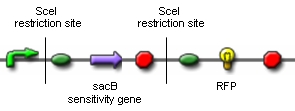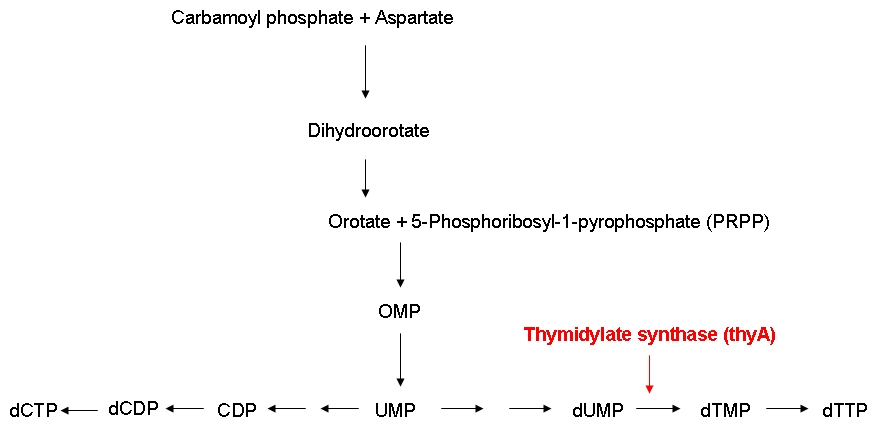|
Overview
In order to approach our goal of creating an E. coli strain carrying a minimal genome, there are three main problems that have to be overcome:
Genome reduction: show that in vivo restriction and religation is possible
Chemostat selection: introduce a limitation that confers a growth advantage to organisms with smaller genomes
Switch circuit: design a biobrick that provides for short-term synthesis of the desired gene products
To prove that in vivo restriction and religation is possible is fundamental to our project which relies on short-term expression of a restriction enzyme and a ligase. While the restriction enzyme will randomly cut DNA, the simultaneous or shortly delayed synthesis of the ligase should religate the DNA. If the DNA is cut at several sites, religation will lead to exclusion of chromosomal fragments in a random manner.
In the continuous culture of a chemostat, those organisms with the highest rate of proliferation will overgrow those with a smaller growth rate. In order to bypass the need of selecting for those E. coli which have successfully reduced their genomes by massive screening of thousands of clones, we need to introduce a constraint that confers a growth advantage to organisms with smaller genomes. We have chosen to introduce mutations in the nucleotide synthesis pathway to achieve this goal. This will render DNA replication the rate-limiting step of proliferation and therefore be advantageous to organisms with small genomes.
Expression of restriction enzymes that cut genomic DNA inside the cell is likely to decrease viability. Actually, the Waterloo iGEM team is using restriction enzymes to kill the cell in their project this year. Therefore, construction of a switch circuit, which allows to restrict expression of the restriction enzyme to a short period of time, is a crucial part of the project.
On the following pages, we will show a detailed description of how we are trying to achieve these three goals.
Outline
|
1) Genome Reduction
Questions:
- Is in vivo restriction and religation possible without killing the cell?
- Does in vivo restriction and religation lead to the exclusion of chromosomal fragments?
Method:
For our proof of concept we ordered the above construct. Only if in vivo restriction by the endonuclease SceI and religation by the T4 ligase leads to the exclusion of the sacB sensitivity gene and the terminator, RFP will be synthesized. RFP-synthesizing cells can then be detected. Unfortunately, the construct has not arrived until today. Therefore, we are working on an alternative construct, which contains an RFP flanked by two SceI restriction sites. In this case, successful in vivo restriction and religation will lead to the loss of the RFP, which can also easily be detected.
Results:
We cloned a lac-inducible promoter in front of SceI and various inducible and constitutive promoters in front of the T4 ligase. During our attempts to design the construct coding for RFP flanked by SceI restriction sites, we managed to insert both restriction sites in front of and following the RFP by annealing oligonucleotide duplexes.
|
2) Chemostat selection
Questions:
- Do E. coli strains carrying differently sized genomes differ in growth rates?
- Can the growth rate of thymidylate synthase knockout strains be modified by regulating the external thymidine supply?
- Do thymidylate synthase knockout strains containing a reduced genome grow faster than strains carrying a larger genome under limiting thymidine concentrations?
Method:
In order to be able to examine the growth behaviors of E. coli strains carrying differently sized genomes, we ordered an E. coli strain (MDS42) whose genome had been reduced by 15 % using a targeted deletion approach. Also, we ordered the wild-type strain which the MDS42 had been derived from. In order to be able to keep track of the individual growth rates of the wild-type and MDS42 strains if grown in a mixed culture, we wanted to label these two strains. Finally, for knocking out the thymidylate synthase, we decided to use phage transduction.
Results:
We successfully knocked out the thymidylate synthase, both in the wild-type and the MDS42 E. coli strains. Also, we managed to label the wild-type and the MDS42 E. coli strains by transformation of low-copy plasmids encoding different reporter proteins. Finally, we successfully performed growth experiments showing that the growth rate of thymidylate synthase knockout strains can be influenced by regulating the external thymidine supply.
|
|
3) Switch circuit
picture
Questions:
- How is it possible to generate a genetic device that provides for inducible short-term expression of a protein of interest?
- ???
Method:
We decided to clone.... Additionally, we performed QuickChange mutagenesis to.....
Results:
We successfully cloned.... Also, we generated xxx by QuickChange mutagenesis.
|
|
|
 "
"

